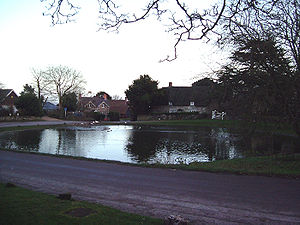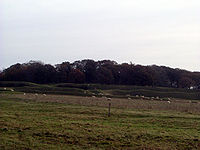Difference between revisions of "Cranborne Chase"
(Created page with 'Ashmore pond '''Cranborne Chase''' ({{map|ST970180}}) is a chalk plateau stretching into the counties Dorset, Hampshire a…') |
|||
| Line 1: | Line 1: | ||
[[File:Dorset ashmore 01.jpg|right|thumb|300px|Ashmore pond]] | [[File:Dorset ashmore 01.jpg|right|thumb|300px|Ashmore pond]] | ||
| − | '''Cranborne Chase''' ({{map|ST970180}}) is a chalk plateau stretching into | + | '''Cranborne Chase''' ({{map|ST970180}}) is a chalk plateau stretching into [[Dorset]], [[Hampshire]] and [[Wiltshire]]. The plateau is part of a wider chalk formation in southern Great Britain and lies adjacent to [[Salisbury Plain]] and the West Wiltshire Downs in the north, and the [[Dorset Downs]] to the southwest. The scarp slope of the hills faces the [[Blackmore Vale]] to the west, and to some extent the [[Vale of Wardour]] to the north. The chalk gently slopes south and dips under clays and gravels. |
An area of 379 square miles of the Chase and the adascent downs has been designated the 'Cranborne Chase and West Wiltshire Downs Area of Outstanding Natural Beauty'; the sixth-largest in the country. The highest point is [[Win Green]], in Wiltshire, at 910 feet. | An area of 379 square miles of the Chase and the adascent downs has been designated the 'Cranborne Chase and West Wiltshire Downs Area of Outstanding Natural Beauty'; the sixth-largest in the country. The highest point is [[Win Green]], in Wiltshire, at 910 feet. | ||
Revision as of 09:37, 5 August 2014
Cranborne Chase (ST970180) is a chalk plateau stretching into Dorset, Hampshire and Wiltshire. The plateau is part of a wider chalk formation in southern Great Britain and lies adjacent to Salisbury Plain and the West Wiltshire Downs in the north, and the Dorset Downs to the southwest. The scarp slope of the hills faces the Blackmore Vale to the west, and to some extent the Vale of Wardour to the north. The chalk gently slopes south and dips under clays and gravels.
An area of 379 square miles of the Chase and the adascent downs has been designated the 'Cranborne Chase and West Wiltshire Downs Area of Outstanding Natural Beauty'; the sixth-largest in the country. The highest point is Win Green, in Wiltshire, at 910 feet.
The downs are named after the village Cranborne, which had a manor house and a small monastery. The word "chase" comes from its use for royal and lordly hunts, and it is known that several Kings including John, Henry VIII and James I hunted here on the downs.
The Chase was owned by the Earl of Gloucester until it passed to King John by his marriage to Gloucester's daughter, Avisa. The land remained in the hands of the Plantagenet and Tudor monarchs until James I granted the rights to Robert Cecil, 1st Earl of Salisbury.
Much of the Chase is still owned by large estates such as Kingston Lacy.
Contents
History and archaeology
The downland has a long history with many earthworks and archaeology from the Neolithic age onwards. The dense woodland originally covering the downs would have gradually been cleared by the first farmers, but would have grown back repeatedly over the centuries as soils became exhausted and the agricultural carrying capacity of the land was exceeded several times over the course of six millennia. Much of the area therefore remained wooded from the Middle Ages until Second World War.
There are many Neolithic and Bronze Age monuments, including the henge monuments at Knowlton and the remains of a number of Iron Age settlements on the downs, most notably the hill fort at Badbury Rings. A Roman villa has been dug by Time Team.[1] During the Saxon invasion of Britain, the Britons kept the invaders out of Dorset by building Bokerley Dyke, a defensive ditch, across the Roman Road that runs across the downs from Dorchester to Old Sarum.
The downs have been sparsely populated since Anglo-Saxon times, largely preserving archaeology until Second World War when the need for agricultural land outweighed the archaeological importance. It was here that Augustus Pitt Rivers developed modern archaeological field work in the 19th century.
Geography
Hills
The landscape of Cranborne Chase is remarkably varied, its most dramatic scenery being near the boundary between Dorset and Wiltshire where the chalk downland rises sharply to the rounded summits of Breeze Hill, with the hairpin bends of the B3081 climbing Zig Zag Hill on its northwestern flanks, and Win Green. Nearby, another prominent top, Melbury Hill above Melbury Abbas, "appears almost like an island rising above the flat, sea-like expanses of" Compton Abbas airfield.[2]
Further south are two more summits on an outlier of the Chase that define its southern limits: Hambledon and Hod Hills.[2] [3]
Wildlife and plantlife
An area of 1,115 acres of Cranborne Chase has been notified as a biological Site of Special Scientific Interest since 1975.
As some of the wooded areas in the chase are centuries old, they possess a diverse ground flora that is associated with such sites. The area is one of the richest in southern England for numbers of lichen species; over 160 have been recorded.[4]
Outside links
- Countryside Agency: Cranborne Chase and West Wiltshire Downs AONB
- AONB dedicated website
- Dorset County Council: Cranborne Chase AONB
- English Nature citation sheet for Cranborne Chase
- Cranborne Chase AONB Woodfair
References
- ↑ "Channel4.com - Time Team - Cranborne Chase". 2005-02-19. Archived from the original on 2005-02-19. http://web.archive.org/web/20050219094735/http://www.channel4.com/history/timeteam/2004_cran_t.html. Retrieved 2011-12-04.
- ↑ 2.0 2.1 The face of Dorset — Cranborne Chase at www.dorsetlife.co.uk. Accessed on 24 Mar 2013.
- ↑ Dorset Downs and Cranborne Chase at www.naturalengland.org.uk. Accessed on 24 Mar 2013.
- ↑ Plantlife
- Pitt-Rivers, Michael, 1968. Dorset. London: Faber & Faber.
Coordinates: 50°57′41″N 2°02′39″W / 50.96142°N 2.04409°W

